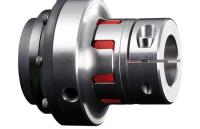 Add My Company
Add My Company
Sign In
How to Select Backlash-Free Couplings
28-01-2019

Understanding & Selecting Backlash-Free Jaw Couplings
Backlash-free jaw couplings are couplings with zero clearance between the convex spider legs and concave jaws of the coupling. The inside diameter of the flexible spider is also solid, whereby a standard spider is hollow, which affects radial stiffness and peak torque and helps limit deformation caused by heavy acceleration or high speeds is further prevented. Backlash-free couplings are often comprised of a curved profile that is press-fitted onto a spider with raised contact points which help to maintain spacing. While the tight fit increases stiffness, it also maintains a relatively constant relationship between the input and output shaft without lost motion, thus providing an accurate operation.
Backlash-Free Coupling Applications
As a general comment, backlash-free applications are all about positioning and accuracy. As a result, backlash-free coupling designs are one of the most desirable options for systems that require abrupt starts and stops, as they are specifically designed to handle shock loads. Using the incorrect type of coupling for your application can cause unnecessary stress on your system. For instance, a complete system slowdown may be required to prevent motor bearing damage caused by frequent stops and starts with an incorrect coupling. Therefore, it’s important to properly select backlash-free couplings that protect the life of your motor by dampening impulse loads and minimizing shock.
Selection Criteria
Shaft sizes and bores are obviously critical components to consider when selecting a jaw-type coupling. However, there are a few additional criteria to consider when selecting a backlash-free coupling in particular.
Torque & Torsional Stiffness: One of the most important criteria to consider when selecting jaw-type couplings is the level of torque it will be required to handle. To determine this, you would multiply the power involved (kW) by a constant of 9550 and divide by speed (rpm). A coupling’s torque range is primarily determined by hub material and size, but it can be increased by inserting stronger, more rigid elements. Utilizing a more rigid element increases the torsional stiffness of the entire coupling and heightens its ability to transmit power. The correct amount of torsional stiffness is paramount in preventing the coupling from winding up during abrupt acceleration and deceleration.
The flexible spiders for KTR’s ROTEX GS series are available in five different kinds of Shore hardness. In applications such as servo drives, demanding high positional control, variety in options of element shore hardness can be advantageous to find the right performance. However, it must also be considered that couplings with more rigid elements have a reduced ability to mitigate torsional vibration and manage misalignments. Underlying all considerations of torsional stiffness and flexibility is the requirement for correct system alignment and this impact his will also have on a successful operation.
Inertia: Inertia is the ability of an object to resist a change in position. For backlash-free couplings, inertia should be relatively low as it requires less energy to move the system and therefore promotes higher acceleration.
Hub Type: Pertinent to backlash-free applications, the hub type selected, and the connection it provides, will influence the overall performance of the applications. Standard hub choices will include options with and without keyway. In high frequency reversing applications a key way can be subject to undesired wear. Other options, such as clamping hubs, can be supplied with and without keyways, and offer an improved fit over a standard bore and key.
Another popular option is a clamping ring hub which offer even greater shaft connection, and higher operating speeds.
A more exotic option is a hydraulic clamping hub type, which only requires a single screw for applying clamping force and can be mounted/dismounted 1000’s of times whilst still maintaining excellent concentricity.
KTR Backlash-Free Coupling Options
At KTR, we offer three different backlash-free coupling types for a variety of applications:
• Backlash-free jaw couplings
• Steel lamina couplings
• Metal bellow-type couplings
ROTEX® GS by KTR is a backlash-free, torsionally flexible jaw coupling that has a proven track record on feed drives with ball spindles that is characterized as the first choice in positioning technology across the world.
While backlash-free couplings are suitable for abrupt stopping and starting, some applications actually require a bit of backlash. Therefore, it’s important to thoroughly understand your equipment and application to ensure the correct coupling is selected. With that being said, we’re always here to help and if you have any questions, all you have to do is ask!
For more information on How to Select Backlash-Free Couplings talk to KTR U.K. Ltd
Enquire Now
List your company on FindTheNeedle.

